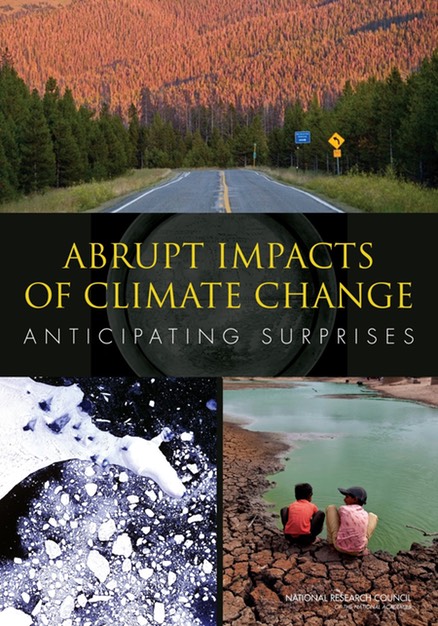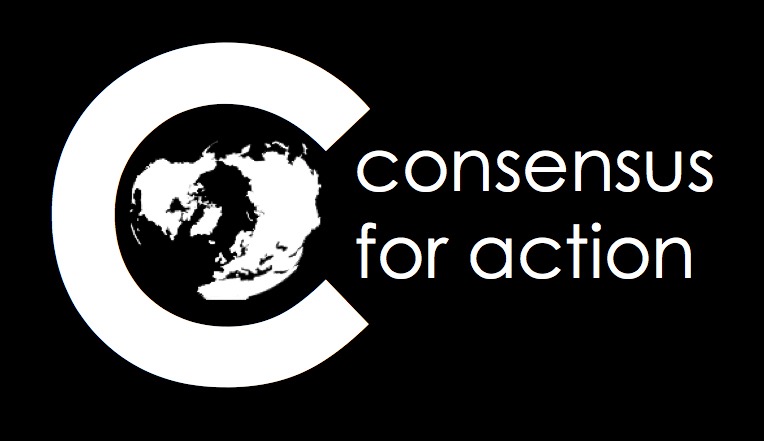ConsensusForAction Blog
What to Expect When You’re Expecting Abrupt Climate Change
NOTE: The National Research Council recently published a report entitled Abrupt Impacts of Climate Change: Anticipating Surprises. Two of the authors, James W.C. White and Richard B. Alley, offer their perspectives on the report’s key messages in this blog. Sponsored by the U.S. intelligence community, the National Oceanic and Atmospheric Administration, the National Science Foundation, and the National Academies, the report summarizes current knowledge about the likelihood and timing of potential abrupt changes, and comments on their societal implications.

The plot twists and turns of the 2004 movie “The Day After Tomorrow” may be science fiction, but they were inspired by the science fact of the 12,000-year-old Younger Dryas event. The abrupt northern cooling into this millennium-long event, and even more abrupt warming as it ended, shifted climate around the globe and may have contributed to the extinction of numerous species of large-bodied mammals in North America.
The Younger Dryas gave us a valuable lesson on the possibility of abrupt climate change—shifts that occur so fast that ecosystems or economies have difficulty adapting. A recent National Research Council report, Abrupt Impacts of Climate Change: Anticipating Surprises, looks at abrupt changes that could take place this century and finds that concern is increasingly focused on the ability of even gradual climate change to force potentially damaging jumps in ecosystems and economies.
Superstorm Sandy overtopping the entrances to the New York subways and Hurricane Katrina breaching the levees of New Orleans are two examples of this: relatively slow sea-level rise, and perhaps gradual increases in the severity of large storms, helped trigger devastating damage to local infrastructure in just hours.
Consider also the Arab Spring, beginning in 2010, which toppled governments and sparked protests and rebellions across the Mideast and north Africa. Many social stresses contributed, but a spike in food prices was rather clearly involved in triggering unrest. This run-up in food prices in turn had many causes, but one contributor was the drought and heat wave of 2010 in the Russian wheat regions. And that in turn was made worse and/or more likely by human-caused global warming.
It is far, far too glib to draw a straight line from slowly rising CO2 to rapidly crumbling governments, but slow changes including those in climate did push the region across a threshold that triggered rapid, uncertain, and potentially costly changes. To borrow from the Pentagon, the changing climate is a threat multiplier.*
There is some good news in the report. Two decades of focused research have helped scientists determine that some abrupt changes once considered potential threats are unlikely to take place over the near term.
For example, extensive scientific research has shown that while freshening of the North Atlantic from Greenland melt and other processes is likely to cause regional changes and may have a broader footprint, Younger Dryas-type jumps are unlikely. Similarly, methane locked in sea-floor clathrates, and organic material in permafrost soils, can provide large and damaging positive feedbacks on global warming. But giant methane belches changing the climate greatly and rapidly are not expected because the system has safety valves that moderate the most extreme possibilities.
Research often works this way. Early attention is frequently focused on possibilities that may be very remote, but have very high impacts. Subsequent research typically narrows or eliminates the “fat tails” of this probability distribution, making the risk/benefit relationship clearer and more quantified, Such research can also lower costs. We buy insurance against low-probability/high-impact events, so narrowing the fat tails can improve our understanding of risks, providing better estimates of potential insurance costs for known risks and eliminating the need for insurance against possible outcomes now found to be too remote to warrant concern.
Occasionally though, subsequent research may find an answer out in one of the fat tails, motivating efforts to reduce risks (and thus insurance costs). So far, we cannot exclude this possibility for collapse of the West Antarctic ice sheet. The ice sheet has survived many millennia, and its modern mass losses are only a small fraction of the ongoing sea-level rise. These observations plus modeling suggest that the likelihood of rapid collapse in the very near future is probably low.
However, retreat of now-thinning Thwaites Glacier in West Antarctica from its current stabilized position could create a situation capable of calving icebergs more rapidly than anywhere on the ice sheet today by processes that may not be fully included in modern models. Even a relatively modest increase in the rate of sea level rise, for example three feet of sea level rise within thirty years (the period of a typical mortgage) instead of within 100 years—would be a game changer for our thinking about sea level rise. Further research will be required to narrow the very broad uncertainties in this case.

Among the unknowns: more-rapid-than-expected collapse of large ice sheets, as happened with the Larsen B Ice Shelf in Antarctica during one month in 2002 (photo courtesy of NASA). The impact would be faster sea level rise than models currently are predicting.
It is important to realize that abrupt change is not a far-off, future threat. Earth is already experiencing sudden increases in extinction rates and the rapid disappearance of late-summer Arctic sea ice.
Even if we take aggressive actions to slow greenhouse warming now, continued climate changes—both gradual and abrupt—are unavoidable. And an incremental shift could be all it takes to push a system across a threshold to abrupt change with devastating consequences.
The difference between a storm surge just below and just above a levee system can be measured in centimeters and billions of dollars—and the difference between a healthy ecosystem and the extinction of many species could come down to just one degree of temperature change. Absent efforts to anticipate and reduce vulnerabilities, Sandy in the subways and even the Arab Spring may be harbingers of events to come.
So what can we do to prepare for abrupt climate changes?
The report calls for an abrupt change early warning system to quantify assets and flag potential shifts in our environment, and help researchers and policymakers prioritize mitigation efforts. By preserving, maintaining and expanding our monitoring capability, targeting areas of greatest concern, and making data, decisions and warnings available in improved ways, many of the costs of expected and unexpected climate changes and their effects could be avoided or reduced.
We already have the capability to “stress test” human and natural systems, using science to learn where we are most vulnerable, and to guide informed choices to reduce those vulnerabilities. And advances in climate and weather forecasting, merged with advances in communicating forecasts and warnings to the public and policymakers, have reduced the potential damages from droughts, hurricanes, tornadoes, and other natural hazards. An abrupt change early warning system could extend those successful applications of science in the public good to reduce the most damaging impacts of the changing climate.
By James W.C. White (jwhite@colorado.edu) and Richard B. Alley (rba6@psu.edu)
White is a Professor of Geological Sciences and Director of the Institute of Arctic and Alpine Research at the University of Colorado. He chaired the committee that authored the NRC report. Alley is Evan Pugh Professor of Geoscience at Pennsylvania State University and one of the distinguished panel experts that authored the report.
Other References for This Piece:
* For the national security community’s discussion of “threat multipliers” see, for example, http://www.cna.org/reports/climate and http://www.scribd.com/doc/115962650/Global-Trends-2030-Alternative-Worlds
The 2013 NRC report updates a previous one published in 2002, entitled Abrupt Climate Change: Inevitable Surprises, from a National Research Council committee that was chaired by Richard Alley.
Otto, F.E.L., N. Masses, G.J. van Oldenborgh, R.G. Jones and M.R. Allen, 2012, Reconciling two approaches to attribution of the 2010 Russian heat wave, Geophysical Research Letters 39(4), doi:10.1029/2011GL050422
Sternberg, T., 2012, Chinese drought, bread and the Arab Spring, Applied Geography 34, 519-524

